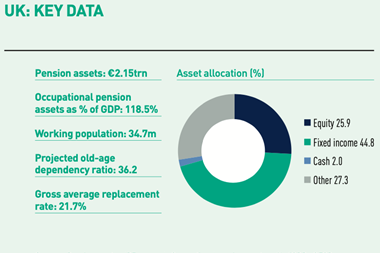UK defined benefit (DB) scheme funding has improved overall despite an aggregate deficit of £129bn (€152bn) across underfunded schemes, the Pension Protection Fund (PPF) said following publication of the latest edition of The Purple Book.
In its 16th edition and now with interactive features, the publication provides comprehensive data on and analysis of the UK DB landscape, tracking trends in scheme funding, demographics, asset allocation, and more.
On a section 179 basis – defined as the level of assets needed to needed to secure benefits in at least in line with PPF compensation – the overall net funding position improved to a surplus of £46.9bn as at 31 March 2021, compared with a deficit of £90.7bn the year before, although just under half of schemes remained in deficit.
Last year the combined funding shortfall across two-thirds of schemes was £229bn, at the height of the coronavirus-driven financial market turmoil.
The aggregate funding ratio increased to 102.8% at the end of March 2021 from 94.9%, driven mainly by market movements.
“While it’s positive to see such an improvement in scheme funding, we’re extremely mindful that this has mainly been driven by market movements and not a proportional increase in scheme de-risking,” said Lisa McCrory, the PPF’s chief finance officer and chief actuary.
“2,525 of the 5,220 schemes under our protection remain underfunded and have an aggregate deficit of £129bn. Many of these schemes have individual deficits which would, if they were to claim, have a significant impact on our balance sheet.”
The significant improvement in the funding levels of the PPF and the schemes it protects means that the lifeboat fund’s probability of success has improved from 83% to 95%. This refers to how likely PPF is to reach its target of being at least 110% funded by 2030.
Bond allocation nearly at two-thirds
As concerns asset allocation, the proportion of schemes’ assets invested in fixed income rose, from 69.2% to 72%, and that of equities fell, from 20.4% to 19%.
Within bonds, the proportions were broadly unchanged, with that of index-linked bonds changing the most, increasing from 46.1% to 47.2%.
Within equities, the UK-quoted proportion fell from 13.3% to 11.6%. Similarly the proportions of overseas-listed equities decreased slightly from 69% to 68.3%, while private equities increased from 17.7% to 20.1%.
The Purple Book also covers risk reduction measures taken by pension schemes. According to the PPF, based only on current recovery plans in place, total annual recovery plan payments are indicated to decrease by around 94% over the next 10 years, from £12.2bn in 2021 to £800m in 2031, as schemes increasingly become fully funded on a technical provisions basis.
According to The Purple Book, DB schemes with more than 5,000 members make up almost 75% each of total assets, liabilities and members in the PPF-eligible universe, but only form 7% of the total number of schemes.
There has been no change in the proportion of schemes open to new members – 11% – although schemes that are closed to new members continue to close also to new benefit accrual, up from 46% in 2020 to 48% in the 2021 Purple Book.
There are currently 9.7 million DB scheme members in the UK, down from 9.9 million last year.
The report can be found here. The PPF is holding a webinar at 10am UK time on Thursday, 9 December to delve into the detail.











No comments yet